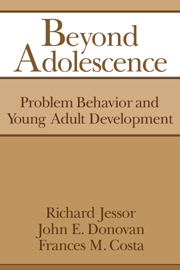Book contents
- Frontmatter
- Contents
- List of tables and figures
- Preface
- Part I The approach
- Part II Young adulthood
- Part III Development and change
- 7 Psychosocial development from adolescence to young adulthood
- 8 Linking proneness to problem behavior in adolescence with involvement in problem behavior in young adulthood
- 9 Involvement in problem behavior in adolescence/youth and outcomes in young adulthood
- Part IV Conclusions
- Name index
- Subject index
9 - Involvement in problem behavior in adolescence/youth and outcomes in young adulthood
Published online by Cambridge University Press: 07 October 2009
- Frontmatter
- Contents
- List of tables and figures
- Preface
- Part I The approach
- Part II Young adulthood
- Part III Development and change
- 7 Psychosocial development from adolescence to young adulthood
- 8 Linking proneness to problem behavior in adolescence with involvement in problem behavior in young adulthood
- 9 Involvement in problem behavior in adolescence/youth and outcomes in young adulthood
- Part IV Conclusions
- Name index
- Subject index
Summary
In this chapter, the last in the triad concerned with development, we take up another important question, one not addressed by the other two: Does involvement in problem behavior in adolescence/youth constrain subsequent development? Does it, in some way, result in lesser attainment, or in more limited success, or, perhaps, in less satisfaction in young adult life? In short, is there evidence that problem behavior among the adolescents and youth in our samples mortgages their future as young adults?
Although not clearly defined as such in the literature, this issue is inherently a developmental one. Development is considered to be the outcome of the interaction of person and environment over time. Whatever the person attribute specified and assessed in adolescence – for example, high value on achievement, or low self-esteem, or, as in our focus here, involvement in problem behavior – its implications for and potential impact on later life are realized only in interaction with the concrete situations, contexts, and environments of ongoing experience. The fact that the latter are rarely measured in the usual longitudinal design does not in any way controvert the logic of their intrinsic contribution to whatever outcome is specified in later life. To argue otherwise is again to commit, in yet another way, the “ontogenetic fallacy” (Dannefer, 1984) noted in Chapter 7, that is, to attach the causal vector to the person attribute at Time 1, and then to explore the apparent unfolding of its consequences over time.
- Type
- Chapter
- Information
- Beyond AdolescenceProblem Behaviour and Young Adult Development, pp. 251 - 270Publisher: Cambridge University PressPrint publication year: 1992



